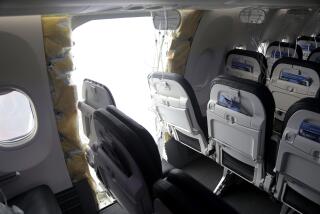Probe Focuses on Jet’s Center Fuel Tank
- Share via
SMITHTOWN, N.Y. — Investigators examined burned pieces of Trans World Airlines Flight 800’s center fuel tank Tuesday in hopes of determining whether it exploded, possibly as the result of a bomb, or was burned in a spreading fire.
An explosion of the fuel tank could point to a bomb or to some major mechanical malfunction, while fire damage only could rule it out as the source of the blast that brought down the 747 jetliner four weeks ago today.
“There’s evidence of a fire there,” said James K. Kallstrom, an FBI assistant director who is leading the criminal review. “There’s sooting and all that black stuff from the fire.
“Whether that’s an explosion or just a fire, or if the damage is from the ripping or other forces that took place in the air, it’s very difficult to say,” Kallstrom said. “But all that’s being analyzed now.”
The jet carried fuel in its wing tanks for the flight from New York to Paris. Investigators have said that the center tank, which held less than 100 gallons at takeoff, would have been filled with fumes, making it highly explosive if ignited.
“There’s a lot of damage in that area,” National Transportation Safety Board Vice Chairman Robert Francis said Tuesday. “There’s a lot of smoke and burn in that wreckage. I would not want to say whether there was an explosion at this point. But we are still debating that.”
Stormy weather, including waves of 9 feet, forced Navy salvage workers and scuba divers Tuesday to postpone most of their search and recovery efforts. More foul weather is expected today.
“We have nobody in the water right now,” said Rear Adm. Ed Kristensen. “We have nothing in the water looking at anything.”
Authorities have determined that the 747 broke apart after climbing above 13,000 feet, with the front section of the plane plummeting to the water and the main fuselage dropping to 8,000 feet and then erupting in a massive fireball.
About half of the TWA wreckage has now been found in 120 feet of water about a dozen miles from the East Moriches, N.Y., coastline. But pieces that have not been recovered include a fourth engine, the left wing and more pieces of the center fuel tank.
All 230 passengers and crew members were killed. The number of bodies recovered remains at 199.
Officials earlier learned that wreckage from the cockpit and front cargo hold showed no signs of a bomb explosion in those areas, so they have turned their scrutiny to the middle section of the plane--including the center fuel tank, the galley kitchen and food carts, and the main passenger cabin area.
To learn more about what occurred in the middle of the plane, they are reassembling the wreckage from that section at a Long Island, N.Y., hangar. In addition, forensic tests for bomb residue and other debris are continuing on Long Island and at the FBI laboratory in Washington.
Conflicting news reports have claimed that some of those tests, either here or in Washington, have proved positive for bomb residue. Kallstrom, asked to discuss those discrepancies, responded angrily.
“My only comment,” he said, “would be that if that is coming from anyone under my supervision, I would recommend their termination.”
More to Read
Sign up for Essential California
The most important California stories and recommendations in your inbox every morning.
You may occasionally receive promotional content from the Los Angeles Times.











